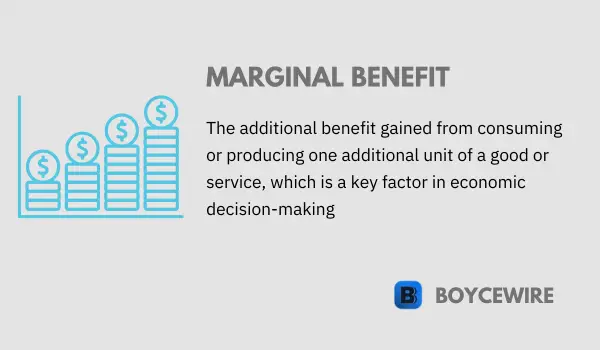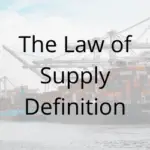Marginal Benefit: Definition, Types, Formula & Examples

What is Marginal Benefit?
Marginal benefit is an essential concept in economics that refers to the additional satisfaction or utility a consumer receives from consuming one extra unit of a good or service. This concept plays a crucial role in understanding consumer behavior, demand, and resource allocation. By examining marginal benefit, economists and decision-makers can make informed choices about production, consumption, and policy.
Key Points
Understanding Marginal Benefit
To comprehend the concept of marginal benefit, it is necessary to first understand the idea of utility in economics. Utility refers to the satisfaction or happiness a consumer derives from consuming goods or services. Each additional unit of a good or service consumed typically provides some level of utility to the consumer.
Marginal benefit is the change in total utility derived from consuming an additional unit of a good or service. In other words, it measures the extra satisfaction a consumer gains from one more unit of consumption. The relationship between marginal benefit and demand is closely tied, as it represents the maximum amount a consumer is willing to pay for an additional unit of a good or service. As a result, the demand curve can also be viewed as a marginal benefit curve, reflecting consumers’ willingness to pay at different levels of consumption.
Factors Influencing Marginal Benefit
Various factors can influence the marginal benefit a consumer derives from consuming an additional unit of a good or service. These factors include:
Income level
A consumer’s income can affect their marginal benefit, as those with higher incomes may be willing to pay more for additional units of a good or service.
Preferences and Tastes
Individual preferences and tastes can have an impact as consumers will derive different levels of satisfaction from consuming different goods and services.
Availability of Substitutes
The presence of substitute goods or services can have an effect. If there are close substitutes available, the marginal benefit of consuming an additional unit of a good or service may be lower, as consumers can easily switch to another product that provides similar satisfaction.
Time Preferences
Time preferences, or how consumers value present consumption versus future consumption, can also have an affect. If a consumer places a higher value on consuming goods or services immediately, their marginal benefit for additional units may be higher than for those who are more patient.
Marginal Benefit Examples
Marginal benefit refers to the additional satisfaction or utility gained from consuming or using one more unit of a good or service. Here are some examples of marginal benefit in various scenarios:
- Studying for an Exam: A student is preparing for an upcoming test and decides to study for an additional hour. The marginal benefit of this extra hour of studying could be a higher test score, better understanding of the material, or increased confidence in their knowledge.
- Buying a Second Sandwich: A person buys a sandwich for lunch and enjoys it. The marginal benefit of purchasing a second sandwich might be the additional satisfaction they derive from eating it. However, the marginal benefit of the second sandwich is likely to be lower than the first, as the person might be less hungry or enjoy the taste less after already having eaten one sandwich.
- Investing in a Home Renovation: A homeowner decides to invest in a home renovation project. The marginal benefit of each additional improvement (e.g., new flooring, upgraded appliances, or a fresh coat of paint) might be an increase in the home’s value, enhanced aesthetics, or improved functionality.
- Hiring an Additional Employee: A business owner hires an additional employee to help manage their growing workload. The marginal benefit of this new employee could be an increase in productivity, allowing the business owner to focus on more strategic tasks, or improved customer service.
- Buying More Insurance Coverage: An individual decides to increase their insurance coverage, purchasing a more comprehensive plan. The marginal benefit of the additional coverage might be greater peace of mind, knowing that they are more protected against potential financial losses, or the ability to cover higher expenses in case of an emergency.
In each of these examples, the marginal benefit represents the additional value or satisfaction derived from making an incremental decision, such as consuming one more unit of a good or service, investing in a project, or allocating resources.
Marginal Benefit Formula
The marginal benefit formula helps quantify the additional satisfaction or utility gained from consuming one more unit of a good or service. It is typically calculated as the change in total benefit (∆TB) divided by the change in the quantity consumed (∆Q).
Marginal Benefit (MB) = (∆TB) / (∆Q)
Where:
- MB = Marginal Benefit
- ∆TB = Change in Total Benefit
- ∆Q = Change in Quantity Consumed
To apply the marginal benefit formula, you need to have information about the total benefit derived from different levels of consumption. This data can be obtained through market research, surveys, or historical data analysis.
Here’s a step-by-step process for calculating marginal benefit using the formula:
- Determine the total benefit at the current consumption level (TB1) and the total benefit at the increased consumption level (TB2). Total benefit can be expressed in monetary terms, satisfaction levels, or any other relevant metric.
- Calculate the change in total benefit (∆TB) by subtracting the total benefit at the current consumption level (TB1) from the total benefit at the increased consumption level (TB2).
- ∆TB = TB2 – TB1
- Determine the change in quantity consumed (∆Q) by subtracting the current quantity consumed (Q1) from the increased quantity consumed (Q2).
- ∆Q = Q2 – Q1
- Finally, divide the change in total benefit (∆TB) by the change in quantity consumed (∆Q) to calculate the marginal benefit (MB).
- MB = (∆TB) / (∆Q)
Calculating marginal benefit helps individuals and businesses make informed decisions about whether to increase their consumption of a particular good or service, as it allows them to weigh the additional benefits against the costs of such a decision.
Types of Marginal Benefit
1. Private
This is the additional benefit that an individual consumer receives when they consume one more unit of a good or service. It is the direct benefit that accrues to the consumer and influences their consumption decisions.
2. Social
This encompasses both private marginal benefits and any external benefits that result from consuming an additional unit of a good or service. External benefits are positive effects on society or other individuals that are not captured in the market price, such as reduced pollution or increased public health.
3. Public Goods
Public goods are goods that are non-excludable and non-rivalrous, meaning that one person’s consumption does not reduce the availability for others, and it is difficult to prevent non-payers from benefiting. The marginal benefit of a public good refers to the additional benefit to society from providing one more unit of the public good, such as additional street lighting or national defense.
4. Production
This refers to the additional benefit a producer receives from producing one more unit of a good or service. It is often measured as the additional revenue generated from selling that additional unit (marginal revenue) and influences production decisions.
5. Marginal Environmental Benefit
This type of benefit refers to the improvement in environmental quality resulting from one additional unit of an environmentally friendly action or a reduction in a polluting activity. Examples include the marginal benefit of planting one more tree, reducing carbon emissions by one ton, or preserving one more acre of natural habitat.
Marginal Benefit and Decision Making
Marginal benefit plays a vital role in decision making for consumers, firms, and governments. Understanding the concept can help inform these decisions:
- Consumer choices: Consumers make choices about what goods and services to purchase based on the marginal benefit they receive from each option. By comparing the benefit of different goods and services, consumers can allocate their resources in a way that maximizes their overall utility.
- Firm production decisions: Firms consider the marginal benefit of producing additional units of their goods or services when making production decisions. They aim to produce up to the point where the marginal benefit equals the marginal cost, ensuring they are maximizing profit while efficiently allocating resources.
- Government policy and resource allocation: Governments also use marginal benefit analysis to determine how to allocate resources and implement policies. By considering the benefit of various programs and initiatives, policymakers can make informed decisions that maximize social welfare.
The Law of Diminishing Marginal Benefit
The Law of Diminishing Marginal Benefit is an essential principle in economics that states that, as more units of a good or service are consumed, the additional satisfaction gained from consuming each unit tends to decrease. In other words, the additional benefit of each successive unit is generally lower than that of the previous unit. This concept has significant implications for decision making, as it helps explain why consumers and firms may adjust their behavior as they consume or produce more units of a good or service.
Marginal Benefit and Cost Analysis
In economics, marginal benefit is often compared with marginal cost to facilitate optimal decision making. Marginal cost refers to the additional cost incurred from producing or consuming one extra unit of a good or service. By comparing the two, individuals, firms, and governments can make decisions that maximize overall utility or profit.
For example, a consumer may decide to purchase more units of a good if the additional benefit exceeds the marginal cost, as this indicates that the additional satisfaction gained from consumption is greater than the additional expense. Similarly, a firm will produce more units of a good if the marginal benefit (or revenue) it receives from selling the good is greater than the marginal cost of producing it.
Applications of marginal benefit and cost analysis can be found in various economic situations, such as determining the optimal level of pollution control, allocating resources for public goods, and evaluating the costs and benefits of government policies.
Conclusion
Understanding the concept of marginal benefit is crucial for making informed decisions in economics. By examining the additional satisfaction derived from consuming or producing goods and services, individuals, firms, and governments can allocate resources more efficiently and effectively.
The comparison with marginal cost is particularly important for decision making, as it allows for the identification of the optimal level of consumption or production that maximizes utility or profit. As a result, it plays a vital role in shaping economic outcomes and driving the behavior of consumers, firms, and policymakers.
FAQs
Marginal benefit is the additional benefit derived from consuming or producing one additional unit of a good or service.
Marginal benefit can be calculated by subtracting the total benefit of consuming or producing n units of a good or service from the total benefit of consuming or producing n+1 units.
Marginal benefit contributes to total benefit, but as more units of a good or service are consumed or produced, it generally decreases while total benefit may continue to increase or level off.
Marginal benefit is a key factor in determining consumer and producer surplus, which are measures of the economic welfare gained by consumers and producers in a market.
About Paul
Paul Boyce is an economics editor with over 10 years experience in the industry. Currently working as a consultant within the financial services sector, Paul is the CEO and chief editor of BoyceWire. He has written publications for FEE, the Mises Institute, and many others.

Further Reading
 Substitution Effect: Definition & Example - The substitution effect occurs when consumers switch to substitute goods as prices rise. For example, if the price of chicken…
Substitution Effect: Definition & Example - The substitution effect occurs when consumers switch to substitute goods as prices rise. For example, if the price of chicken…  Accounting Equation - The accounting equation represents the fundamental relationship between a company's assets, liabilities, and owner's equity.
Accounting Equation - The accounting equation represents the fundamental relationship between a company's assets, liabilities, and owner's equity.  Law of Supply: Definition & Example - The law of supply is the relationship supply has with price. As prices rise, businesses supply more. As prices fall,…
Law of Supply: Definition & Example - The law of supply is the relationship supply has with price. As prices rise, businesses supply more. As prices fall,… 
